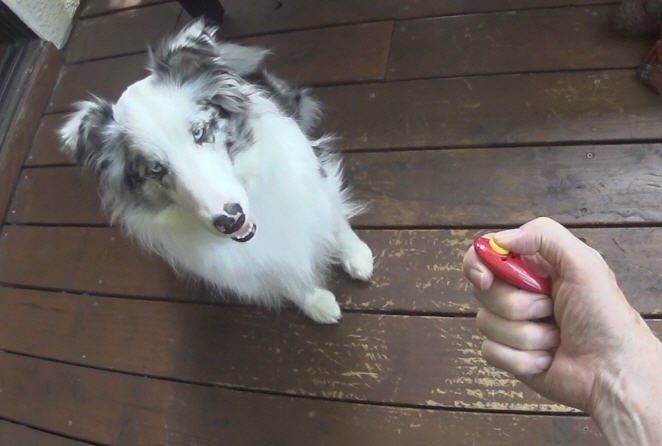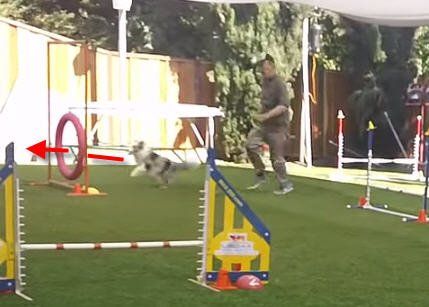Clicker Training Exposed
Using a Clicker to Train Your Dog.
This is an introduction to clicker training. For a complete course on clicker training in dog agility, click here. (A free preview is included.)
1. Clicker Very Effective. A clicker can be very effective in dog training! You can use it to train your dog to do things you never thought possible! If you don't yet have a clicker for dog training, you can easily get one here from Amazon
[
NOTE: to subscribe for more free lessons, click here. ]
I'll give some helpful tips on using a clicker in this article. and help you understand the underlying psychology that makes it work.
Clickers were first introduced in print in an article written by Harvard University Professor, B.F. Skinner in an issue of the Scientific American, December, 1951.
On this page you can see a video from a 1971 film showing B.F. Skinner demonstrating operant conditioning and "clicker training" with a pigeon. Please watch the video before you continue reading!
2. How to Train Animals. The info here, is based on the ideas in Skinner's article "How to Train Animals" (December 1951, Scientific American). Before Skinner wrote the 1951 article, he had done thousands of experiments with various animals in his laboratory starting in the 1930's.
Two pigeons were even taught to play a game of ping pong with each other -- a lot more fun than sitting in a cage! Recently rats trained by college students have even competed against each other in a game of basketball!
3. The Clicking Sound. In the video, when the machine (called a magazine) released a pellet of food, it made a distinct clicking sound. Skinner watched the pigeon and when it moved its head ever so slightly in the correct direction, he pressed a button, and the magazine made a clicking sound and the food was released
4. The Click of the Magazine
Skinner observed that the click of the magazine helped to alert the pigeon that a reward was coming. Because the clicking sound was repeatedly paired with the dispensing of a pellet of food, the click itself became a reward (or more technically speaking) a conditioned reinforcing stimulus. Skinner called the clicking sound a secondary reinforcer. In Skinner's article, he referred to a cricket -- a toy that made a clicking sound when you pressed it. Toy crickets were banned because they had a sharp metal edge that could cut children who played with them. But later these toys were redesigned so the sharp edge was removed and called "clickers."
5. Primary reinforcer. The primary reinforcer is the food pellet in most of Skinner's experiments. A primary reinforcer is something that an animal naturally loves and is willing to work for without any prior conditioning. Other primary reinforcers for dogs include: water, goat milk, toys, plastic bags, plastic bottles, and chance to run. A primary reinforcer does not need to be conditioned, it is something that a dog craves to do or have from birth or shortly after.
6. Why use a clicker? Skinner advocated the use of a clicker as a secondary because of his initial experience with the clicking sound of food dispensing magazine in the laboratory -- see the rare film from 1971! Skinner advocated a clicker also because the clicking sound is very unique and consistent. Also, because -- and this is very important -- the sound can be emitted immediately. If you've got a clicker handy, you can click the moment a dog starts to show the tiniest movement toward the behavior you would like to see. And once conditioned, the clicking sound is a clear unmistakable signal to your dog. It is much more effective than "good boy, yes, good job" and the like.
Skinner asserted in his Scientific American article that...
...the delay of even one second in giving a reinforcer lessens the effectiveness of a reinforcer considerably.
After clicking at the proper precise moment, you can then offer the dog a treat and your timing of the treat delivery does not have to be immediate. That's because the click has already served as a secondary reinforcer.
7. Using a Clicker in Dog Training. When using a clicker to do dog training, we must first establish the sound of the clicker as a secondary reinforcer. This is sometimes called "charging the clicker." But that way of speaking about the process does not clearly describe what is happening. It is better to say we need to condition the clicker to be a secondary reinforcer by repeatedly pairing it with a primary reinforcer.
8. Conditioning the Clicker. Turning the clicking sound into a secondary reinforcer is easy to do in a short while. Here's how:
At a time when your pooch is quite hungry. prepare about 30 or so tiny treats -- so tiny that all of them will not satisfy your doggy's hunger. Sound the clicker and immediately toss a tiny bit of sustenance or scrap of healthy food for your loved one.
Wait for about 30 seconds. Then toss another treat and immediately sound the "cricket" with no preparatory movements like reaching for a treat. You toss the treat because you want to make sure your doggy will be interested enough to go for it. If he doesn't go for it, he may not be hungry. Try again later or find something else like, say, a piece of cheese. (Momo loves cheese.)
9. Begging. Now your dog may show clear begging behavior. She may watch you eagerly, which is fine. But if she barks or pounces on you, sop that behavior by ignoring it and turning away from your dog until she gives up her arrogant demands.
Never click or give a treat when your dog is confronting you. Hold up until she backs off, then click and treat. Your conditioned reinforcer is working when your doggy turns quickly and approaches the spot where you tossed the nourishment.
Test this a few times. Wait until your dog is in an unusual position, then click and treat. Verify that your little (or not so little) baby quickly approaches the treat. -- If she does not, wait a while longer and try again.
10. Add a verbal reinforcer. Besides clicking I suggest you also say "Yes!" (or another chosen
unique
word) when you give your dog a tiny, tiny treat. Try to say "yes" in a clear consistent manner with a sharp staccato voice. Again, make the treats so tiny that giving your dog 30 of them will not cause satiation.
I think pellets of Taste of the Wild Dog Food are excellent for this purpose.
You want your honey to be hungry and eager to get the treats. By paring "Yes" (or another chosen word) to the primary reinforcer, you are also setting up the word to have the same power as a clicker!
The clicking sound is somewhat better than the word "Yes" because it is more distinct and consistent. However, the disadvantage of the clicker is that often you may not have one handy when you need it. And sometimes, as in agility training, you need both hands free. And in agility trials you are forbidden from using any training aids, including a clicker.
But the clicker is a great thing to use at first because just holding it in your hand gives you a reminder to look for good behavior. The clicker reminds YOU to use a positive approach and to take small steps to perfection in your training.
Once your dog is conditioned to the clicker and "yes," you can begin a training exercise. (It's actually training for you as well as for your dog.)
11. Shaping a Behavior. Once you have setup the clicking sound and the word "Yes" as a conditioned secondary reinforcer, try using it to shape a behavior. When you shape a behavior, it's kind of like sculpting. You don't start with a finished beautiful statute. Instead, you mold the image gradually. So when shaping a behavior you start rewarding the tiniest approximation of the desired behavior. (continued -- see #12.)


16. Primary Reinforcers.When you begin using "yes" and/or a click as a secondary reinforcer, make certain to offer a primary reinforcer, too, like a morsel of food.. Albeit not everybody concurs, I do NOT think this is always necessary. After the secondary is solidly setup, it is fine to now and again use the clicker or "yes" without giving a primary reinforcer.
Keep in mind that the secondary reinforcer is likewise a marker -- it marks right conduct and conveys to your pooch that she is on track!. Sometimes, it's I think it is imperative to convey "yes" to our little darling without offering the primary reinforcer. After all, in trials, we cannot use primary reinforcers, only secondary ones.
But when you are just getting started with clicker training, it is best to keep offering the primary reinforcer each time you click. That way the click will keep its power as a secondary reinforcer.
17. Intermittent Reinforcement . Once you dog has mastered a behavior and responds well to your cues, it is important to stop reinforcing every response. Skinner was short on food pellets one day and decided to reinforce every so often instead of all the time. His experiments showed that by doing so the behavior became even more strongly attached to the cues. It's like a human playing the slot machines. It's more fun and interesting if we are reinforced every now and then instead of every time.
I like to use a secondary reinforcer each time, but withhold the primary reinforcer until it is time according to the schedule to deliver it. The secondary reinforcer then acts as a marker of correct behavior and encourages the dog to keep going.
But, again, if you are just getting started with secondary reinforcers, I suggest that you consistently pair them with primary ones, until the behavior you want is firmly established and under "stimulus control."
When a behavior is under stimulus control, you can give a cue or command of some sort and your dog will immediately exhibit the desired behavior.
After a while, the joy of just doing a behavior will provide all the reward a dog needs. After all, the chance to run is also a primary reinforcer, especially if a dog has been resting in his/her crate. That's why Momo can quickly handle 20 obstacles in a Masters or Premier Level AKC course. She just enjoys running with me and showing off her Wonder Woman Powers.
For complete training in Clicker Training for dog agility, please check out this guaranteed online course: DOG AGILITY CLICKER TRAINING (thinkific.com)
Using a
Whistle -- while a clicker is great in a quiet environment, you may want to use a loud whistle to get your dog's attention and come to you, especially if your dog is engaging in protective barking. First train the dog to come and get its reward when the whistle is sounded. Blow the whistle, call your dog and treat in a quiet environment. Then after the dog is well-trained to come to you, try blowing the whistle to call your dog to you when he is barking too loudly. When you dog comes, have him do a simple trick like sit or a more advanced dog agility directional trick. Then click and treat.



